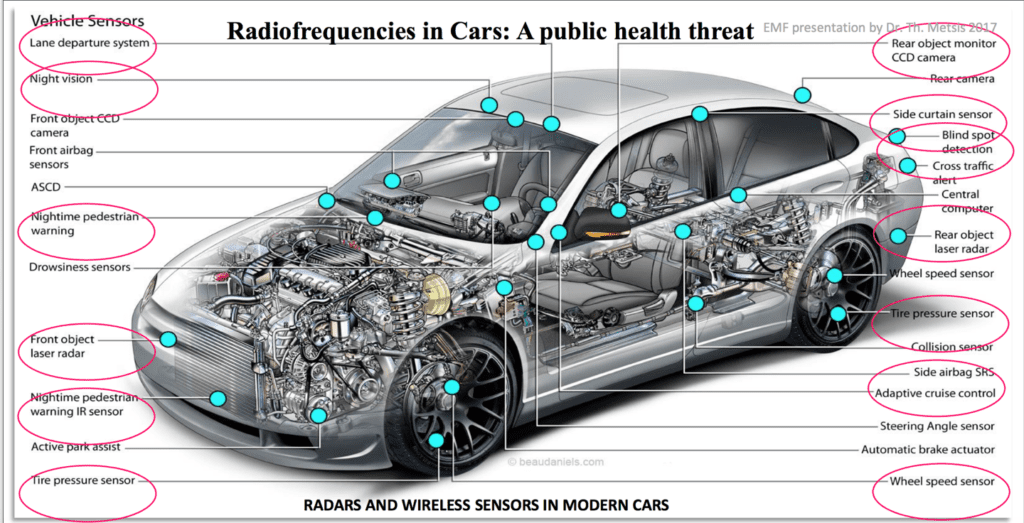Given that you’re reading this post on the Shield Your Body website, you’re likely already aware of the dangers of EMF.
- You know to limit your use of devices like Wi-Fi and cellphones
- You know better than to buy a house near a cell tower or high-tension power"Power" in a scientific context refers to the rate at which work is done or energy is transferred. In simpler terms, it's how fast something is using energy. For example,... lines
- And you may even turn off your breakers at night.
But what about cars and EMF radiation"Radiation" in the context of Electromagnetic Fields (EMF) refers to the process by which energy is emitted and transmitted through space or a material medium in the form of electromagnetic...? Have you considered the EMF exposure you’re getting while inside your car?
Even the most EMF-aware among us have been guilty of overlooking one of the biggest exposures in our daily lives — our automobiles. So how much EMF does your car emit? Is it really something you need to worry about? As with all things EMF-related, it depends…
There are hundreds of different makes and models of cars on the road today, including brand new cars and cars that are decades old. There are gas-powered cars, diesel, hybrids, and electric. Because there are so many variables, you can expect wildly fluctuating levels of EMF as well.
In this post, we’ll look at the main sources of EMF radiation in your car, the differences between gas, diesel, electric and hybrid, how to choose a ‘low-EMF vehicle’, and how to reduce your exposure in a car you already own.
Sources of EMF in Vehicles
No matter the type of car you drive, it inherently has many electrical components. Most modern cars have several communication systems like BluetoothFrom the perspective of someone concerned about the health effects of electromagnetic radiation, understanding Bluetooth radiation is crucial, especially in our increasingly wireless world. Bluetooth technology, ubiquitous in our daily..., radar and Wi-Fi hotspots. This means that your car could have elevated levels of all the main fields – electric, magnetic, radio frequencyRadio Frequency (or RF), a subset of EMF, encompasses electromagnetic wave frequencies ranging from about 3 kilohertz (kHz) to 300 gigahertz (GHz). These frequencies are extensively used in modern wireless..., and dirty electricityDirty Electricity, also known as electrical pollution, refers to the presence of irregularities or distortions in the normal electrical current within a wiring system. These distortions, which deviate from the.... And because many of us spend several hours in our cars every single day, we should give our cars as much EMF consideration as we do our homes.

Want to Slash Your EMF Health Risks?
Want to Slash Your EMF Health Risks?
Good! Learn the one small change you should make right now.
First, let’s consider the electrical wiring in a car. When was the last time you rode in a car where you had to manually roll down the window or that didn’t have automatic steering? The large majority of modern cars come standard with power locks, electric seat controls, heated seats, power windows and locks, fancy stereos, air conditioning, and a lot more. This inevitably means that wires are running throughout the entire cab and carry an electric fieldIn the context of electromagnetic fields (EMF), the term "field" refers to a region in space where electric and magnetic forces are exerted. An electromagnetic field is generated by electrically... with them.
Additionally, you have a fuel injector, anti-lock breaks, fuel pumps, ventilation fans, tire pressure sensors, headlights, engine fans, electric control panels, and other various motors and controls – all with their own unique contribution to electric fieldsDefinition and Nature of Electric Fields Electric fields are a fundamental aspect of electromagnetic fields, created by electric charges, either stationary or moving. These fields represent the force that electric..., magnetic fieldsDefinition and Nature of Magnetic Fields Magnetic fields are a fundamental aspect of electromagnetic fields, produced by moving electric charges (electric currents). The strength of a magnetic field is measured... and dirty electricity.
As if all these sources weren’t enough, most cars since the mid-2010s are fully equipped with an array of radio frequency"Frequency" in the context of electricity, Electromagnetic Fields (EMF), and wireless communication, can be thought of as the number of times something happens in a second. Specifically, it refers to... emitting devices. The most obvious is the Bluetooth to cellphone connectivity. Many cars come equipped with radar for crash prevention and emergency services like OnStar. It used to be only luxury cars that came with back-up cameras, but this is an increasingly standard feature.

Many cars are now WiFi hot spots, and car insurance companies offer you a reduction in your premiums if you install a tracking device to monitor your driving behaviors and mileage. Very soon, we should expect to see vehicle-to-vehicle communication devices to help prevent accidents, and of course, 5G"5G" refers to the fifth generation of wireless communication technology, a step up from the previous 4G, 3G, and 2G networks. It's designed to provide faster internet speeds, more reliable... antennas that will communicate with the ‘Internet of Things’. Additionally, we’ll have self-driving cars with who knows how many radio frequency (RF) devices that will continuously emit high levels of RF to stay connected to the grid.
Some parts of the US are testing out ‘Smart Pavement’. And don’t forget the radio-frequency identification (RFID) key that most modern day cars use.
And you thought your house had a lot of ‘hot spots’! With all of these variables, you can see why your car really deserves a bit more attention than you may have thought. But what about the different types of cars? Is a gas-powered car better than electric? What about diesel or hybrids? Of course, we all want to reduce our consumption of greenhouse gasses, so is it safe to choose ‘greener’ cars?
Like I mentioned before, there are hundreds of different makes and models of cars, and they each come with their own set of advantages and disadvantages. This is true for the various types of engines as well.
Gas, Diesel, Electric and Hybrid
Because of how electric and hybrid cars are made, it’s true they have more opportunity for elevated fields for the following reasons:
1. Large AC batteries. While gas-powered cars have batteries, they’re really only used to start the car and for the small electrical components like the dashboard and lights. The batteries are also often located farther away from the cab where people sit. Hybrids and electric cars, however, have much larger batteries that continually power the motor.
2. In hybrid and electric cars, the batteries are often placed much closer to where people sit, and in the case of the TeslaThe "tesla" is a unit of measurement in the International System of Units (SI) used to quantify the strength of a magnetic field. Named after the inventor and electrical engineer..., directly underneath the cabin floor (ie, right under the feet).
3. These batteries convert DC-AC via a power converter and require more electronic wiring throughout the entire vehicle.
4. Charging the car creates substantial amounts of dirty electricity (DE). When you charge your car in the garage, you are putting extremely high levels of DE onto the wires of your entire home. This is especially problematic as most people charge the car overnight when the occupants are sleeping – the time of day when we want our EMF exposure to be as low as possible.
I recently went to a friend’s home in Boise to see what kind of DE they were getting from their solar panels. To my surprise, I found that the DE was quite low when I was there. (They had a Solar Edge system that has been shown to be ‘cleaner’ than others.) I was about to leave, happy with my results, when I noticed they had an electric car. Our of curiosity, I asked them to plug it into its charging station. Here is a picture of the DE readings on my Oscilloscope before the car was plugged in:

Those thin lines going up and down are from 3 dimmer switches that were turned on inside the house; with those off, the sine waveThe term "wave" in the context of Electromagnetic Fields (EMF), frequency, and energy is a fundamental concept in physics and essential in understanding various natural phenomena and technological applications. A... looked pretty good. Here is what it looked like after their Chevy VoltThe term "Volt," named after the Italian physicist Alessandro Volta, is a unit of electric potential, electric potential difference (voltage), and electromotive force (EMF) in the International System of Units... was plugged in:

That is a LOT of dirty electricity! If you want to see this in action, check out this video of my colleague Damon Coyne as he tests a home with two electric vehicles.
5. Lastly, electric cars are beginning to gain more popularity. As such, most of them are outfitted with all the bells and whistles like Bluetooth, Wi-Fi, radar, tire sensors, etc., increasing the potential for elevations in all four fields.
All of this combined means that you have more opportunities for an increase in your total EMF exposure when inside an electric or hybrid vehicle.
However, don’t forget about the potential sources in a gas-powered vehicle: alternators, fuel pumps, spark plugs, turning motors, batteries, and wires running all throughout the cab. In many cases, they can have just as high readings as electric or hybrid cars. To test this out, I recently measured the EMF levels in a Ford Escape, A Chevy Volt, a Toyota Prius, a Toyota Sienna, and a Tesla, and got surprising results from each. While I assumed that the electric vehicles like the Tesla and the Volt would have the highest electric fields, I actually measured just as high, if not higher levels in the gas-powered cars.
I also assumed the electric and hybrid cars would have the highest magnetic fields. The Tesla and Prius both had very low magnetic fields, but the Chevy Volt did have quite high readings. If you’d like to see the videos of my testing these cars, you can see them in this video.
What this means is that every single car is going to be different. Just because it’s gas, diesel, electric or a hybrid, doesn’t mean that it’s automatically better or worse than the others. You must always test.
The radio frequency levels I tested in these cars were significantly higher in the Tesla and Prius, but were also elevated in the Ford Escape. This has more to do with the fact that those cars were newer models, which is similar to the increase of RF in any newer vehicle.
Testing Shows
In 2010, Consumer Reports tested 13 vehicles using an ELF/Magnetic Field meter to see which ones emitted the most EMF. And here are the results.
| Vehicle tested | Peak EMF reading at driver’s feet (milligauss) |
| 2008 Chevrolet Cobalt | 30 mG |
| 2008 Chevrolet Tahoe Hybrid | 14 mG |
| 2008 Subaru Impreza | 6 mG |
| 2006 Toyota Prius (hybrid) | 4 mG |
| 2008 Subaru Legacy | 4 mG |
| 2008 Toyota Prius (hybrid) | 4 mG |
| 2008 Mini Cooper Clubman | 3 mG |
| 2008 Nissan Altima Hybrid | 3 mG |
| 2008 Toyota Highlander Hybrid | 2 mG |
| 2008 Nissan Murano | 1.3 mG |
| 2008 Toyota Sequoia | 1 mG |
| 2007 Chevrolet Suburban | 0.8 mG |
| 2008 Toyota Highlander | 0.5 mG |
While most vehicles showed relatively low EMF emissions, the 2008 Chevy Cobalt stood out in this test. As you can see, its EMF emissions reached 30mG. And that’s a lot— capable of seriously damaging your health.
What’s even more interesting is that all of these cars are from before 2010. They were neither as sophisticated nor had the kind of wireless features we have in cars today. And this only means one thing: the EMF emissions from vehicles have increased significantly.
So, it’s a bit surprising that, to date, no government or organization has set any regulations on how much EMF a modern vehicle can emit.
Here’s what the NY Times has said:
“There is no federal standard that sets allowable levels of exposure. Government safety tests do not measure the strength of the fields on vehicles, although Honda and Toyota, the major hybrid manufacturers, say their internal controls ensure that their cars do not pose an additional risk to occupants.”
Automotive Radar: The Ignored EMF Source
Besides the sources I mentioned above, there’s one more, and it’s often overlooked when talking about EMF emissions from cars: automotive radar.
You may have noticed that many new cars include a suite of safety sensors. And you can find them even in the base models with the lowest-tech features.
Dr. Ronald Kostoff from the Georgia Institute of Technology says that these radar sensors emit EMF beams that travel huge distances and can even impinge on other cars and pedestrians.
He also mentions that these automotive radars can function on frequencies ranging from 24 GHz to 77 GHz, similar to what the modern-day 5G network emits. And this is a serious problem because we know very little about the health effects that may be incurred at these frequency ranges.
So far, we only have data on the biological effects of EMFs from networks at 4G or below.
And these sensors are also getting advanced by the minute.
For example, in 2018, EE Times (Electronic Engineering Times) talked about a car sensor that could detect small movements and even breathing to indicate human or animal presence.
It also noted that “child occupancy detection” will likely become a common feature in future cars. These sensors will allow the car to look under covers like blankets to see if there’s a child underneath.
And this is good in terms of safety. The only problem is that it’s untested.
“The aim seems to be to deliberately radiate the cabin with radar RFR for various detection purposes,” says Dr. Kostoff. “They make no mention about potential power levels.”
How To Choose a ‘Low EMF’ Car
As cars are a daily necessity for most of us, this puts us at severe risk of developing EMF-induced health problems.
So, what can you do?
Choose a low EMF car. Here’s how.
With all of this information, the question remains: ‘How do I find a low-EMF car?’ If you’re in the market for a new (or used) car, there are a few tips to keep in mind so you can get the safest model for your family.
Stick To Standard Options
One of the best ways to reduce your exposure to all of the fields is to purchase a vehicle with only the standard features, no upgrades, and is as stripped down as possible. This means manual windows and locks, no radio, no power steering, and the obvious no wireless communication systems. This will dramatically reduce the amount of electrical components and motors.
Low-tech vehicles like this may be hard to find, and some people just can’t do without the conveniences. No matter the number of upgrades a car does or does not have, you should always test it before buying. Every single car is different, even the exact same make, model and year of any given car can test completely differently. You must always test to know for sure.
Buy Used
Another important consideration is the year of the car. Newer cars are much more likely to have higher radio frequency signals in the form of Bluetooth, Wi-Fi hotspots, RFID keys, radar, back up cameras, etc. Older cars will not have all of these high-tech options, so purchasing an older used car may be a better option. A car that is at least a few years old also has the benefit of being off-gassed to some degree. This is an important consideration as a new car has hundreds of toxic chemicals which cause multiple health symptoms, especially for those that are electro-hypersensitive.
In older cars, you have a better possibility of turning off some of the RF functions like Bluetooth. Most newer cars don’t have the option to disable them. For example, the newer models of the Subaru Outback all have Bluetooth connectivity. You can easily turn it off on the control panel in models up to 2014. From 2015 on, there is no feasible way to disable the signal that I have found.
In some vehicles, you can attempt to remove the fuse that controls the RF signals. But oftentimes the fuse will control other functions like the radio or control panel. So you need to check the feasibility of that before you try it.
Specific Models
Some EHS people report specific models and years of cars are more tolerable than others. I have not tested these specific cars to verify, but I know many EHS people that find the following cars acceptable:
- Diesel Mercedes 1980-1985
- Ford F150, even newer years
- Volvo v70R 1989 and older
While these models have worked for many people, it’s important to reiterate that if finding a low-EMF car is important to you. You must test before purchasing. Every car is different. And there may have been updates or changes made to the vehicle that could make it uncomfortable for you.
Modifications & Shielding
If you already have a vehicle you like, or you’re not in a position to purchase a new one, there are some shielding options and behavior modifications you should be aware of.
First of all, be sure you turn off all RF devices inside the car. Cars are more or less a metal box. When you use a cell phone inside the car, you are bringing the RF signals in through the windows, and then amplifying them as they bounce around inside the cab. Additionally, your phone will increase its power output as you’re driving to try and maintain a signal as you drive closer to and farther from the nearest antenna.
The best practice is to make sure your phone is in airplane mode with Wi-Fi and Bluetooth turned off. GPS will still work in airplane mode. This goes for all other devices in the car as well; tablets, fitness trackers etc.
Even if you don’t have RF devices inside the car, you will still have frequencies from cell towers enter through windows. You can purchase RF-blocking window cling, which is quite effective at blocking those unwanted emissions.
Shielding from electric and magnetic fields is more complicated, but some people have had success to some degree. You likely won’t get the number to zero, but you can get a decent reduction when done properly. The best materials to shield magnetic fields are G-Iron or Mu-metal. These are thick, woven, metal alloys. They work best for shielding sources on the floor and under the dash. It has obvious limitations if the elevated fields are coming from the dashboard or control panel.
To install the shielding, you must first take measurements with a good meter. Make sure to test with the engine running and while driving. Take notes of the highest readings so you can pinpoint the source. Next, remove the carpet or floor mats and cut the shielding material to fit the space. Be careful! The edges are very sharp. Retest to make sure you’re getting a satisfactory reduction. If so, adhere the metal with tape, glue, screws, or whatever works. Replace the carpet and floor mats.
Make sure the new setup does not pose any interference to the driver (nothing poking out that could get caught on a shoe or pant leg). If that goes well, you can work on other hot spots inside the car.
Cars & EMF Radiation: Conclusion
By combining all of the above options, you can create a vehicle that is significantly safer than the one you may now have. And don’t forget about the cheap, easy, good-for-you, no-EMF transportation options like biking, skating and walking.
Of course, those options aren’t always feasible, but when weather and distance permits, they provide the much-desired side-effects of improved cardiovascular function, weight management, fresh air, sun exposure, improved circulation, mental clarity, improved bone structure, and stress relief. What’s not to love about that!
And as the examples covered in this article show, the only way to learn how much EMF you’re being exposed to from all the various tech in your life is to test for yourself. Which is why we’ve posted a lot of free information– including videos, articles and an ebook- explaining how to do that.








